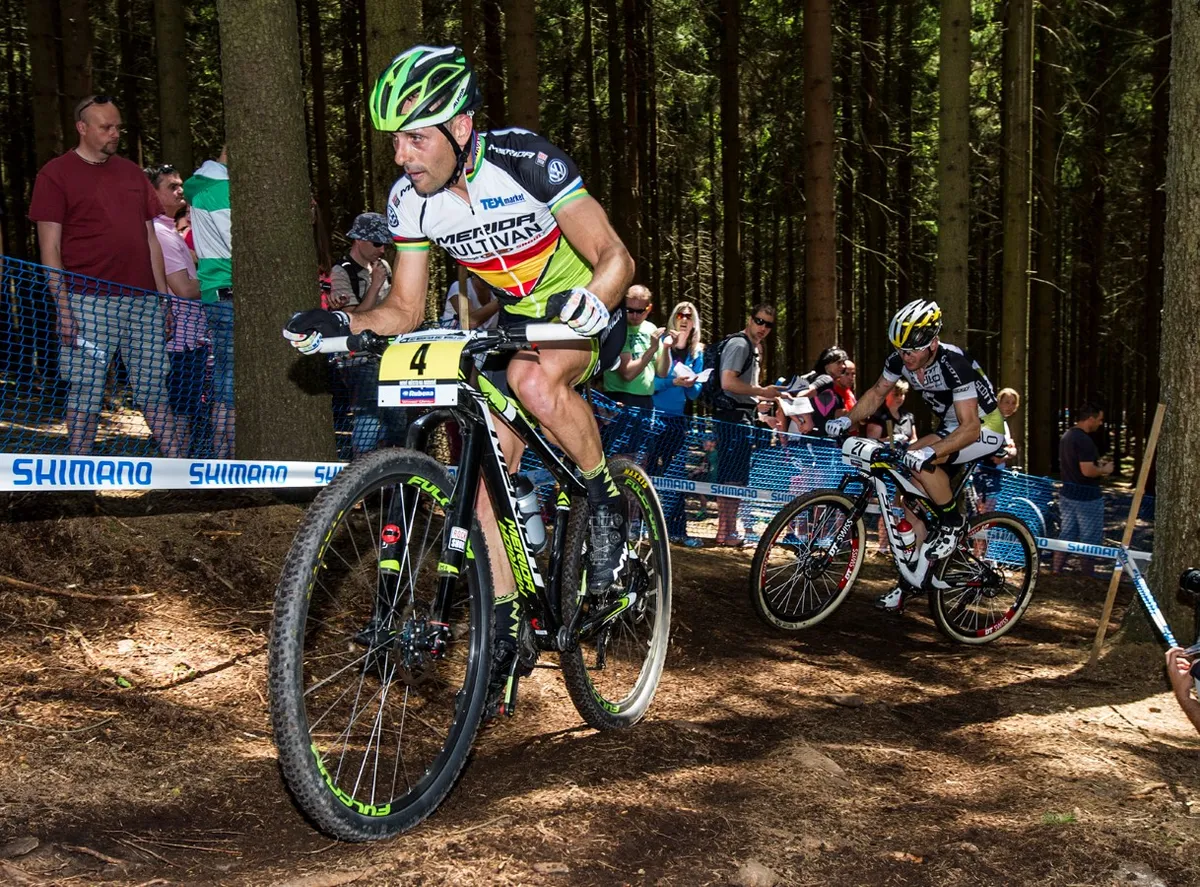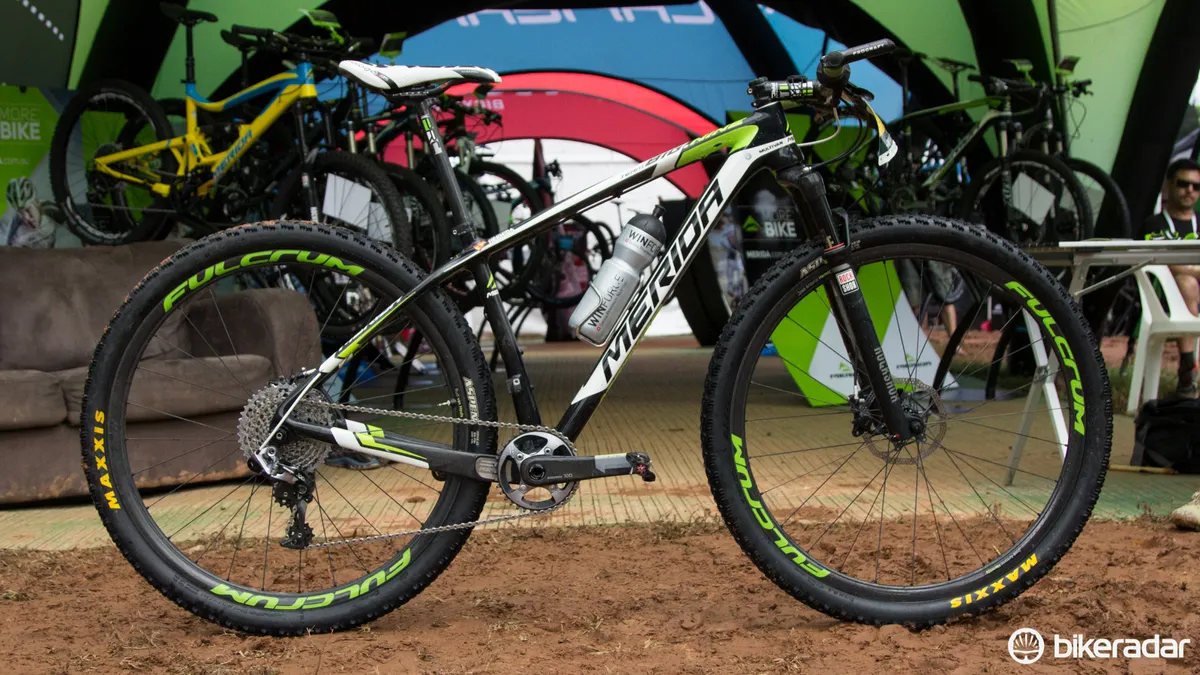José Antonio Hermida Ramos is a rider from the old guard of cross country mountain biking – back when skinny handlebars, 26in wheels, v-brakes and bar ends were the only option. He was the 2010 cross country world champion and 2004 Olympic silver medallist, and this cheerful 35-year-old doesn’t look to be slowing down anytime soon.
While in Cairns, Australia, BikeRadar sat down with Hermida and asked him about his bike setup, opinion on wheel sizes and of current generation course design – before taking a far closer look at the bike of the speedy Spaniard.

José Antonio Hermida at the World Cup third round in Nove Mesto, Czech Republic (credit: CanadianCyclist.com)
Wheel size of choice?
I’m going to use my 29er, not officially, but probably for the whole season. It’s not the perfect wheel for me based on my height – I do fit better on the 27.5 – but for the World Cups you greatly benefit from a 29in wheel. It’s safer, smoother and faster as the courses get rougher.
The 27.5 also accelerates better, but at the end of a race when you have to repeat a dangerous rock garden for the seventh time, it’s just safer to be on the larger wheel and it lets you get away with far more when you’re tired.
Is there an example of a course where you would swap to a 27.5in bike?
In South Africa, Australia and Canada they like to create real mountain bike courses with rough rock gardens and dangerous obstacles. In Europe, the terrain is a little smoother and faster and, on these cleaner courses, the acceleration of a 27.5 may be better. But any time its rough, the 29 is my choice.
Is there something you insist you have on your bike?
My bar ends I couldn’t do without. A painter has a signature in their paint, the bar ends are my signature. 90 percent of riders don’t use them, but I think it’s an advantage as you can open more of your chest, breathe better and push a little harder. I think they are underrated these days.
Dual suspension vs hardtail?
I’m a hardtail rider, but at stage races such as Cape Epic I use full suspension. On those longer races where you are often improvising to the changing terrain, the dual suspension affords you that extra control and comfort. But, in a cross country race where we learn every rock and root, the acceleration of a hardtail makes it the obvious choice.
Will we ever see you racing in baggy shorts?
Nah! It’s not really a trend at the moment, the guys from Cannondale – Fontanna (Marco) and Fumic (Manuel) – are doing it. To me, baggy shorts are like Photoshop to photographers – you’re trying to cover something you don’t want to show!
The bike
As a member of the Multivan Merida team, Hermida does have the choice between The Big.Seven and Big.Nine carbon hardtails as well as a range of dual suspension bikes. With this, his first choice for most races is the Big.Nine CF Team hardtail – a competitively light 8.8kg total.
Since we sat down with Hermida, he was seen at the world cup round three in Nove Mesto, Czech Republic, riding the new upside-down RockShox RS-1 fork. This fork seeks to add greater steering and damping control without a major weight penalty, although judging by RockShox’s own claimed weights, we suspect his bike would have gained an approximate 180g with the fork change compared to the SID XX World Cup he used previously.

The headset bearing is exposed to help reduce the bike's front-end height
With the bigger 29er wheel, some modifications have been made to get the handlebars lower. This includes removal of the headset topcap – running the stem directly on the top bearing, surely leading to a higher bearing wear rate. Additionally, the fork has been reduced to 80mm of travel, helping lower the front by a further 20mm compared with a stock 100mm fork.
With most SRAM-sponsored riders taking to the new single ring trend, Hermida’s XX1 gearing choice is of little surprise. Showing his strength is a rather large 36T front chainring. Helping jump through the wide-range 11-speed cassette is a Grip Shift shifter, something that’s popular among the XC pros owing to its ability to dump a bunch of gears in one move, and the easy shifting in any condition.

What looks to be a prototype carbon 29er wheelset from Fulcrum
The Fulcrum branded wheels are a prototype carbon model that we currently know little about. Sharing some similarity with the current 26in Red Carbon XRP model, these 29er hoops have far smaller hub flanges and unmarked rims. Previously it was rumoured team Multivan Merida were using prototype tubular wheels; these were obviously a clincher type rim.
Hermida has his non-tubeless rear tyre set up tubeless, but unusually uses a tube in the front. With the low tyre pressures used, he claims this ensures he doesn’t roll the tyre when pushing hard into corners.
The frame features a stiffening 142x12mm rear thru-axle; saving a claimed 47g is a FRM TASK-E thru-axle, something that’s possibly chosen to avoid sponsor conflict as much as for its beneficial weight savings.

The Spanish flag appears on Hermida's Prologo saddle
Keeping Hermida comfortable is a custom-covered Prologo Scratch saddle with CPC grippers on the surface. Steering upfront is handled by a rather standard 660mm wide handlebar and 110mm length stem of the PRC (Procraft Racing Components) label.
Complete bike specifications
- Frame: Merida Big.Nine CF Team, size medium (17in)
- Fork: RockShox SID World Cup XX BlackBox, set to 80mm (since seen on RockShox RS-1)
- Headset: Sealed, topcap removed
- Stem: Procraft PRC 110mm
- Handlebar: Procraft PRC Carbon 660mm
- Tape: ESI Racers Edge
- Front brake: SRAM XX
- Rear brake: SRAM XX
- Brake levers: SRAM XX
- Rear derailleur: SRAM XX1
- Shift levers: SRAM XX1 Grip Shift
- Cassette: SRAM XX1 10-42T
- Chain: SRAM XX1
- Crankset: SRAM XX1, 36T chainring, 175mm
- Bottom bracket: press-fit
- Pedals: Time ATAC XC12 Titan Carbon
- Wheels: Fulcrum carbon prototype, FRM Task-E rear skewer
- Front tyre: Maxxis Aspen 2.1in – tube in front
- Rear tyre: Maxxis Aspen 2.1in – tubeless rear
- Saddle: Prologo Scratch Pro CPC nack
- Seatpost: Procraft PRC carbon, straight
- Extras: Procraft bar ends, VDO computer, King bottle cage
Critical measurements
- Rider's height: 1.72m (5ft 7in)
- Rider's weight: 63kg (139lb)
- Saddle height from BB, c-t: 725mm
- Saddle setback: 45mm
- Seat tube length (c-t): 440
- Seat tube length (c-c): 385
- Tip of saddle to center of bar: 555mm
- Head tube length: 110mm
- Saddle-to-bar drop: 30mm
- Top tube length (effective): 599mm
- Total bicycle weight: 8.8kg (19.36lb)
For a closer look at Hermida's bike, be sure to click through the image gallery.














